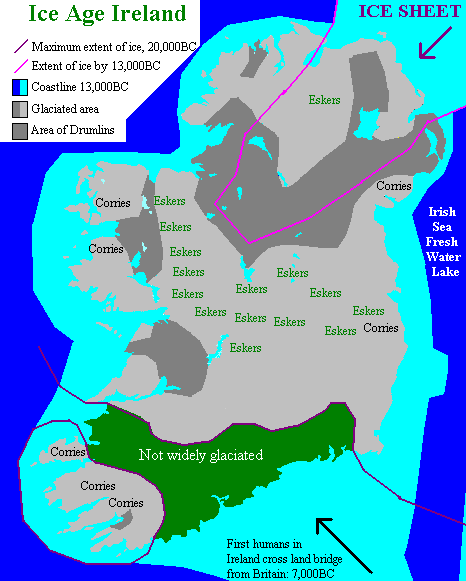|
Colman Mac Duagh
Saint Colman mac Duagh (c. 560 – 29 October 632) was born at Corker, Kiltartan, County Galway, Ireland, the son of the Irish chieftain Duac (and thus, in Irish, ''mac Duach''). He initially lived as a recluse, living in prayer and prolonged fastings, first on Inismore, then in a cave at the Burren in County Clare. With his relative, King Guaire Aidne mac Colmáin (d. 663) of Connacht he founded the monastery of Kilmacduagh, ("the church of the son of Duac"), and governed it as abbot-bishop. He has been confused with Saint Colman of Templeshanbo (d. 595) who was from Connacht and lived somewhat earlier. Early life St Colman was reportedly the son of Queen Rhinagh and her husband the chieftain Duac, born in Kiltartan, now County Galway. Priesthood He was educated at Saint Enda's monastery on Inishmore/''Árainn'', the largest of the Aran Islands and lived there as a hermit. He built a church, ''Teampuill Mor Mhic Duagh'', and a small oratory, ''Teampuill beg Mhic Duagh'', ... [...More Info...] [...Related Items...] OR: [Wikipedia] [Google] [Baidu] |
Roman Catholicism
The Catholic Church, also known as the Roman Catholic Church, is the List of Christian denominations by number of members, largest Christian church, with 1.3 billion baptized Catholics Catholic Church by country, worldwide . It is among the world's oldest and largest international institutions, and has played a prominent role in the history and development of Western civilization.Gerald O'Collins, O'Collins, p. v (preface). The church consists of 24 Catholic particular churches and liturgical rites#Churches, ''sui iuris'' churches, including the Latin Church and 23 Eastern Catholic Churches, which comprise almost 3,500 dioceses and Eparchy, eparchies located List of Catholic dioceses (structured view), around the world. The pope, who is the bishop of Rome, is the Papal supremacy, chief pastor of the church. The bishopric of Rome, known as the Holy See, is the central governing authority of the church. The administrative body of the Holy See, the Roman Curia, has its pr ... [...More Info...] [...Related Items...] OR: [Wikipedia] [Google] [Baidu] |
Inishmore
Inishmore ( ga, Árainn , or ) is the largest of the Aran Islands in Galway Bay, off the west coast of Ireland. With an area of and a population of 762 (as of 2016), it is the second-largest island off the Irish coast (after Achill) and most populous of the Aran Islands. The island is in the Irish-speaking Gaeltacht and has a strong Irish culture. Much of the island is karst landscape and it has a wealth of ancient and medieval sites including Dún Aonghasa, described as "the most magnificent barbaric monument in Europe" by George Petrie. Name Before the 20th century, the island was usually called ''Árainn'' or ''Árainn Mhór'', which is thought to mean "kidney-shaped" or "ridge". It was anglicized as 'Aran', 'Aran More' or 'Great Aran'. This has caused some confusion with Arranmore, County Donegal, which has the same Irish name. The name 'Inishmore' was "apparently concocted by the Ordnance Survey for its map of 1839" as an anglicization of ''Inis Mór'' ("big island ... [...More Info...] [...Related Items...] OR: [Wikipedia] [Google] [Baidu] |
632 Deaths
63 may refer to: * 63 (number) * one of the years 63 BC, AD 63, 1963, 2063 * +63, telephone country code in the Philippines * Flight 63 (other) * 63 (album), ''63'' (album), by Tree63 * 63 (mixtape), ''63'' (mixtape), by Kool A.D. * "Sixty Three", a song by Karma to Burn from the album ''Mountain Czar'', 2016 {{Numberdis ... [...More Info...] [...Related Items...] OR: [Wikipedia] [Google] [Baidu] |
560 Births
56 may refer to: * 56 (number) * one of the years 56 BC, AD 56, 1856, 1956, 2056 * 56.com, a Chinese online video platform * Fiftysix, Arkansas, unincorporated community in United States * Fifty-Six, Arkansas, city in United States * "Fifty Six", a song by Karma to Burn from the album ''Arch Stanton'', 2014 * Cityrider 56, a bus route in the United Kingdom {{Numberdis ... [...More Info...] [...Related Items...] OR: [Wikipedia] [Google] [Baidu] |
Irish Golden Age
The first evidence of human presence in Ireland dates to around 33,000 years ago, with further findings dating the presence of homo sapiens to around 10,500 to 7,000 BC. The receding of the ice after the Younger Dryas cold phase of the Quaternary around 9700 BC, heralds the beginning of Prehistoric Ireland, which includes the archaeological periods known as the Mesolithic, the Neolithic from about 4000 BC and the Copper Age beginning around 2500 BC with the arrival of the Beaker Culture. The Irish Bronze Age proper begins around 2000 BC and ends with the arrival of the Iron Age of the Celtic Hallstatt culture, beginning about 600 BC. The subsequent La Tène culture brought new styles and practices by 300 BC. Greek and Roman writers give some information about Ireland during the Classical period (see "protohistoric" period), by which time the island may be termed "Gaelic Ireland". By the late 4th century AD Christianity had begun to gradually subsume or replace the earlier Celtic ... [...More Info...] [...Related Items...] OR: [Wikipedia] [Google] [Baidu] |
.jpg)
.jpg)
